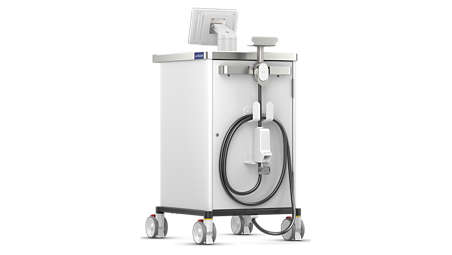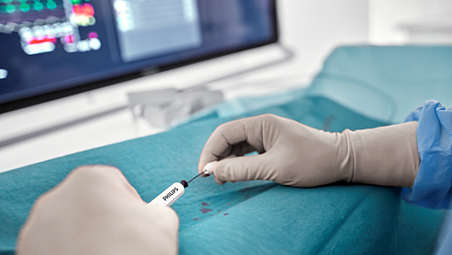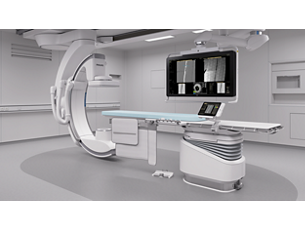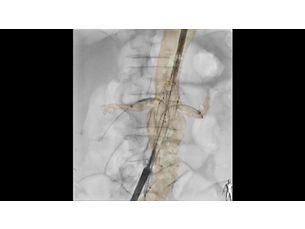- The ‘brain’ of the system
-
The ‘brain’ of the system
The LumiGuide Engine is the core element the brain of the system. This smart unit generates the light which is sent into the fiber-optic cables integrated into the guidewire. It then analyses and interprets the light on its return, to determine the shape and position of the guidewire (and therefore the catheter). The technology used within the LumiGuide Engine is known as Fiber Optic RealShape (FORS). A dedicated touchscreen is attached to the engine for monitoring and altering the system status. The engine can be easily moved to any suitable position outside the sterile zone in the operating room. - AI-based automatic registration
-
AI-based automatic registration
Thanks to deep learning, automatic shape registration of the FORS-enabled Guidewire is seamlessly integrated into the procedure workflow. All you have to do is confirm the wire identification (within the context of the patient anatomy), it's that simple. - A guidewire that visualizes itself
-
A guidewire that visualizes itself
This guidewire is 0.035 inches in diameter and 120 cm long. Its integrated fiber optic cores are essential in determining the position and orientation of the guidewire inside the body. - Work with the catheters you're familiar with
-
Work with the catheters you're familiar with
Thanks to the Philips 3D Hub, you can run most compatible catheters over the FORS-enabled guidewire. In other words, continue to use the catheters of your choice while having them visualized in real-time 3D.
The ‘brain’ of the system

The ‘brain’ of the system

The ‘brain’ of the system
AI-based automatic registration

AI-based automatic registration

AI-based automatic registration
A guidewire that visualizes itself

A guidewire that visualizes itself

A guidewire that visualizes itself
Work with the catheters you're familiar with

Work with the catheters you're familiar with

Work with the catheters you're familiar with
- The ‘brain’ of the system
- AI-based automatic registration
- A guidewire that visualizes itself
- Work with the catheters you're familiar with
- The ‘brain’ of the system
-
The ‘brain’ of the system
The LumiGuide Engine is the core element the brain of the system. This smart unit generates the light which is sent into the fiber-optic cables integrated into the guidewire. It then analyses and interprets the light on its return, to determine the shape and position of the guidewire (and therefore the catheter). The technology used within the LumiGuide Engine is known as Fiber Optic RealShape (FORS). A dedicated touchscreen is attached to the engine for monitoring and altering the system status. The engine can be easily moved to any suitable position outside the sterile zone in the operating room. - AI-based automatic registration
-
AI-based automatic registration
Thanks to deep learning, automatic shape registration of the FORS-enabled Guidewire is seamlessly integrated into the procedure workflow. All you have to do is confirm the wire identification (within the context of the patient anatomy), it's that simple. - A guidewire that visualizes itself
-
A guidewire that visualizes itself
This guidewire is 0.035 inches in diameter and 120 cm long. Its integrated fiber optic cores are essential in determining the position and orientation of the guidewire inside the body. - Work with the catheters you're familiar with
-
Work with the catheters you're familiar with
Thanks to the Philips 3D Hub, you can run most compatible catheters over the FORS-enabled guidewire. In other words, continue to use the catheters of your choice while having them visualized in real-time 3D.
The ‘brain’ of the system

The ‘brain’ of the system

The ‘brain’ of the system
AI-based automatic registration

AI-based automatic registration

AI-based automatic registration
A guidewire that visualizes itself

A guidewire that visualizes itself

A guidewire that visualizes itself
Work with the catheters you're familiar with

Work with the catheters you're familiar with

Work with the catheters you're familiar with
Specifications
- FORS-enabled Guidewire
-
FORS-enabled Guidewire Diameter - 0.035”
Working length - 47’’ (120 cm) long
Tip shape - Angled tip
-
- 3D Hub
-
3D Hub Inner diameter - Compatible with 0.035’’ guidewire
Length - 3.54’’ (9 cm) long
-
- Docking top
-
Docking top Dimensions - (Single piece) Outer Packaging dimensions (h x l x w) = 1.97”x 9.45”x 5.9” (5 x 24 x 15 cm)
-
- FORS-enabled Guidewire
-
FORS-enabled Guidewire Diameter - 0.035”
Working length - 47’’ (120 cm) long
-
- 3D Hub
-
3D Hub Inner diameter - Compatible with 0.035’’ guidewire
Length - 3.54’’ (9 cm) long
-
- FORS-enabled Guidewire
-
FORS-enabled Guidewire Diameter - 0.035”
Working length - 47’’ (120 cm) long
Tip shape - Angled tip
-
- 3D Hub
-
3D Hub Inner diameter - Compatible with 0.035’’ guidewire
Length - 3.54’’ (9 cm) long
-
- Docking top
-
Docking top Dimensions - (Single piece) Outer Packaging dimensions (h x l x w) = 1.97”x 9.45”x 5.9” (5 x 24 x 15 cm)
-
Related products
Alternative products
-
Azurion 7 C20 with FlexArm
- Ceiling-mounted image-guided therapy system with a 20" flat detector for a variety of procedures
- Rotates on no less than eight axes to create virtually unlimited flexibility to perform imaging
- The Axsys intelligent motion control system allows for more independent control for physicians
- Control all relevant applications via the central touch screen module at table side
View product
-
VesselNavigator
- 3D image fusion technology for advanced endovascular procedures
- Supports navigation through complex vessel structures, enhancing clinical outcomes
- Reusing a pre-acquired CTA or MRA reduces the need for contrast enhanced runs
- Philips CTA Image Fusion Guidance may lead to shorter procedure times
View product
-
Azurion 7 C20 with FlexArm
This ceiling-mounted system provides unlimited imaging flexibility for diverse procedures and exceptional positioning freedom for medical teams. Its compact set-up provides a highly cost-effective environment, ready for the procedures of the future. Seamlessly control all relevant applications from a single touch screen at table side, to help make fast, informed decisions in the sterile field. By working around you, Philips Azurion with FlexArm helps you advance your suite performance and deliver superior care.
View product
-
VesselNavigator
VesselNavigator allows reuse of 3D vascular anatomical information from existing CTA and MRA datasets as a 3D roadmap overlay on a live X-ray image. With its excellent visualization, VesselNavigator provides an intuitive and continuous 3D roadmap to guide you through vasculature during the entire procedure.
View product
- * Other devices are expected to be FORS-enabled in the future.


